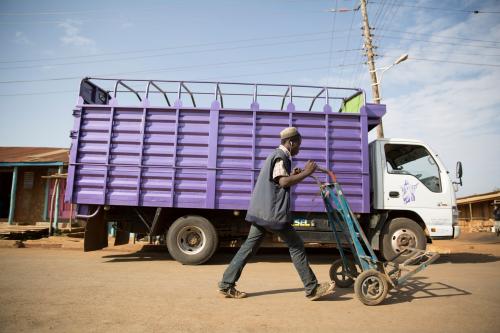In 2020, the global economy is estimated to have shrunk by 3.5 percent while international trade declined by 9.2 percent, in large part due to the COVID-19 crisis. One of the major drags on international trade was the introduction of lockdown policies to contain the spread of the virus. Governments around the world imposed several measures that restricted the mobility of people and goods, which impeded trade flows at local, regional, and international levels.
Lockdown policies led to supply chain disruption by increasing trade costs and delaying or entirely prohibiting border clearance. The onset of the pandemic also created demand shocks, leading to stockpiling of essential commodities such as food products and medical items. Massive unemployment caused by the economic slowdown and business closures has fueled uncertainties, further reducing demand for internationally traded goods, particularly for durables.
In a new working paper, we analyze the short-term effects of lockdown policies by Kenya’s trading partners on the country’s import and export trade. COVID-19 arrived somewhat late in Kenya and other African countries, but its effects have nonetheless been severe. Kenya’s real GDP is estimated to have grown by just 1 percent in 2020, much lower than the 5.4 percent in the previous year, but considerably better than performances of other emerging and developing countries (-2.4 percent) and advanced economies (-4.9 percent). The economic slowdown has led to an increase in unemployment, which was 10.4 percent in the second quarter of 2020.
Measuring the effects of lockdown policies
To analyze the effects of lockdown policies on Kenya’s international trade performance, we use disaggregated, transaction-level data of imports and exports from July 1, 2019 to June 30, 2020. We constructed a weekly series of imports and exports at product level (6-digit HS codes) by country of origin (for imports) and destination (for exports). We subsequently conducted an event study analysis to assess how the introduction of lockdown policies (such as workplace closure, stay-at-home requirements, and restrictions on internal and international travel) by trading partners affected Kenya’s trade flows.
The results show that the introduction of lockdown measures by Kenya’s trading partners had a positive effect on exports but a negative one on imports. Weekly exports to countries that introduced lockdown measures increased by an average of 13 percent, while imports from those countries decreased by 23.4 percent. This suggests that lockdown policies reshuffled existing trade patterns, leading to an increase in trade with some countries and a decline in trade with others.
The change in Kenya’s trade performance reflects both demand- and supply-related responses, with a potentially greater demand effect. The fall in Kenya’s imports was due to a significant disruption of sea cargo imports from countries that introduced lockdown measures, which was large enough to compensate for a significant increase in air cargo imports. This implies a substitution from sea to air cargo trade as a result of lockdown policies, possibly due to the perceived safety of air cargo and cheaper airfares from airlines that faced a collapse in passenger traffic.
Heterogenous trade responses
Both the import and export of food commodities increased in response to the lockdown measures, by an average of 31 percent and 21 percent, respectively. This illustrates the heterogenous effects of lockdown policies across different goods; the increase in the import of food commodities, for example, contrasts with a notable decline in the import of other durable commodities. This likely reflects the income inelastic nature of food commodities, whose demand remained robust despite (anticipated) negative income shocks. Our analysis on the trade of medical goods relevant to the prevention and treatment of COVID-19 did not suggest a notable disruption of trade due to lockdown measures.
Finally, Kenyan exports to countries with more stringent lockdown policies decreased, while imports from them increased significantly. Conditional on lockdown stringency, imports from OECD countries increased (by an average of 16 percent), but imports from China declined (by an average of 30 percent). Imports from China started to contract sharply about five weeks after it introduced lockdown measures, before subsequently recovering to a level closer to the pre-lockdown period.
The bottom line
The results show that lockdown policies not only affected domestic economic activities, but also shaped international trade patterns. Lockdown measures by Kenya’s trading partners had an asymmetric effect on import and export trade, which also diverged by mode of transport, the stringency of lockdown measures, and the identity of the trading partner. Export trade seems to have endured the pandemic without significant disruptions, while imports suffered due to the combined effects of interruptions in sea shipments and a fall in demand.
The results seem to confirm that, compared to prior crises such as the Great Recession, the effect of the pandemic on international trade was muted, especially considering its large impact on economic growth. For non-oil-producing African countries like Kenya, the effects of the pandemic on international trade appear to have been transitory or even positive.







Commentary
How have lockdown policies affected international trade? Evidence from Kenya
March 9, 2021